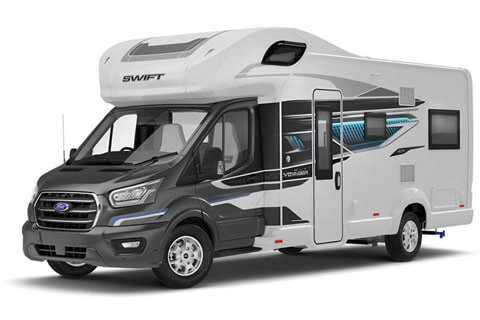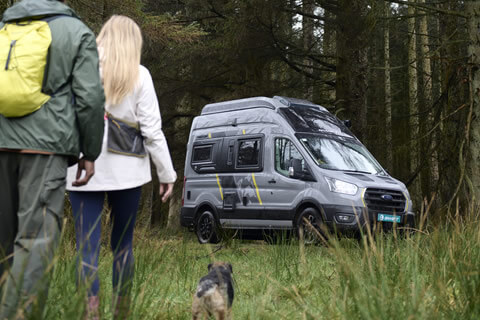What is the average lifespan for a motorhome or campervan?
Published:
Whether you’re interested in buying a new or used motorhome or campervan, it’s good to know how long they should last to understand the value of the investment.
Armed with this information, you can weigh up the new/used benefits more effectively and build a picture of how affordable motorhome holidays are compared to paying for your holidays with lets and hotels.
Is there an average lifespan for a motorhome or campervan?
Yes, there is, and it’s crucial to bear in mind it’s an average which by nature can vary subject to a blend of variables (that we’ll cover later). The average life of a motorhome or campervan is 20 years or 200,000 miles, whichever is reached first, and this can instantly inform you whether to avoid a used model depending on the proximity to either of these numbers, it can also improve the prospect of a new model if you intend to keep it for its full life span.
We can calculate an average price per holiday by making a few assumptions and selecting a price. We can base the calculations on the following:

- New Swift Voyager 475 5-Berth Motorhome - £69,995
- Years of use - 20
- Average holiday/short break per year - 6
- People travelling per holiday - 2
Taking this example we can calculate the following:
20 x 6 = 120
£69,995 / 120 = £583
£583 / 2 = £291
Price per holiday per person: £291
This highlights over the long-term how a new model can be a very cost-effective option, it’s worth noting we haven’t included site fees, tax, insurance, or running costs here but we have also excluded any value of reselling at the end when factoring in depreciation. This calculation is simply to give a broad idea of how to compare the investment of a new motorhome or campervan against existing holidays, and the more you travel per year the lower this number becomes.
What impacts the lifespan?
Exploring an average lifespan with something like a motorhome comes with a multitude of factors that can all impact how long a motorhome lasts. The list below isn’t exhaustive and is designed to give an idea of how elements inside and outside your control will influence the longevity of your camper. We can’t categorically say by how much these elements will impact the lifespan.
Motorhome class
What berth motorhome you need will largely dictate the class you end up with, classes indicate the style and size motorhome and are graded A, B and C, they look like this:
Class A - Large fully integrated motorhomes
Class B - Campervan conversions/panel vans
Class C - Coachbuilt motorhomes smaller than class A
In general, larger vehicles can have slightly shorter lifespans simply because of wear and tear on fundamental working parts like tyres, suspensions, brakes etc., which all come under more pressure over time, but with good care, some of these can be offset. Conversely, a Class B Campervan could exceed the average for the opposite reasons.
Environmental
Where you drive your camper has a tremendous impact on lifespan, for example, if you live near the coast, salt can erode parts of your vehicle quickly, or if you live where the winter season is exceptionally cold and you don’t store your motorhome properly, then it’ll be easier for damp to take hold quicker.
That being said, with good upkeep and preventative measures you can largely mitigate your environment, it’s worth being mindful of them and appropriately factoring in how to adapt and take care of your camper.
It’s also worth noting that all Swift coachbuilt motorhomes are built with SMART Construction which guarantees enhanced structural integrity, improved insulation and all-important weather resistance – ensuring your motorhome will stand the tests of touring and help retain your motorhome’s residual value. The bodyframe of Swift motorhomes are timberless and instead use ‘PURe’ a tough, hard polyurethane based product that is totally impervious to water.

"Investing time and resources in regular servicing not only extends the lifespan of your motorhome but also ensures your safety, preserves its resale value, and minimises its impact on the environment."
Jo Mitchell, Marketing Director at Swift
Usage
How far and how often the motorhome is used will naturally influence its use, for example, most motorhomes and campervan owners average around 4,000 to 5,000 miles which equates to a 20-year lifespan, but if you exceed this consistently you’ll reach that 200,000 mile mark before the 20 years.
This doesn’t affect the value to you if we look at things from a cost-per-holiday perspective though as it would still work out more cost-effective than travelling frequently without a motorhome and paying for hotels.
Servicing
Getting your motorhome professionally serviced annually is one of the most crucial ways to keep it on the road for as long as possible. Plus, with a new Swift motorhome or campervan, it also ensures you maintain your warranty.
We highly recommend you have your Swift serviced by a Swift Group Approved Service Centre because they have direct access to our online customer service system and it gives you peace of mind that everything is running smoothly. We have an extensive servicing network and you can find your nearest service provider.

Servicing helps keep the mechanics of your motorhome maintained, but if you’d like to do your additional checks, here are some recommended areas to keep an eye on. This should not be in place of a professional service and please refer to the official warranty for your vehicle to keep it maintained:
- Engine cleaning (air & oil filters)
- Fluid replacement
- Oil changes every 4,000 to 5,000 miles
- Regular tyre tread checks and replace every 4,000 to 5,000 miles
- Check the brake pads for signs of wear
General care (when in use)
It cannot be understated how impactful regular care is, especially when using your camper. General care means keeping your motorhome in consistently good condition, mainly through regular cleaning and upkeep, some of our key recommendations for general care are:
- Wash the exterior after every use, especially the roof which can be overlooked
- Clean the shower after every use and bathroom at the end of each trip
- Lubricate all slide-out apparatus like awnings every few trips
- Thoroughly clean the windscreen and check for any cracks (repair immediately)
- Regularly use toilet chemicals and correct toilet paper
- Keep all cooking appliances regularly cleaned after each use
- Clean the window seals then lubricate
- Regularly top up the tyre pressure
- Empty the black tank when it reaches ¾ full
Seasonal care (when not in use)
How you take care of a motorhome through the winter or when not in use can impact the lifespan as much as when it’s used, it becomes easier for damp to build and for the cold weather to adversely impact your vehicle if it’s not stored properly. Taking the following actions can ensure it’s tip-top when you dust it off in Spring:
- Store inside or under a shelter or invest in a quality all-over cover. (Swift coachbuilt motorhomes are built with SMART construction, and so this isn’t a requirement unless you are storing the motorhome in particularly harsh winter conditions)
- Drain all tanks (to prevent pipes bursting)
- Disconnect the battery and store it somewhere warm
- Check for small holes or leaks and fix them before storing
- Use a damp catcher to limit moisture build-up over months
- Apply anti-freeze to all tanks and drains
- Thoroughly clean interior and exterior
Summary
In this guide, we’ve specifically looked at the value of a new motorhome or campervan used to the full extent of its lifespan, and 20 years / 200,000 miles or £291 per holiday per person is excellent value based on our conservative calculations.
The more it’s used the more value you squeeze from it, and regular care can prolong your motorhome beyond the average. Ultimately, motorhomes are vessels to facilitate incredible holidays and make terrific memories. Still, they do increase the ease and frequency you can holiday over time which is fantastic value for money.